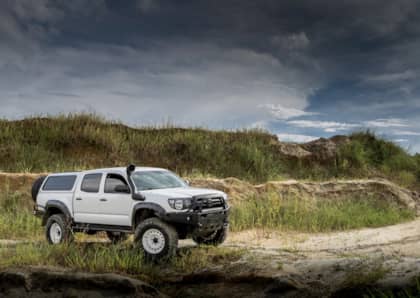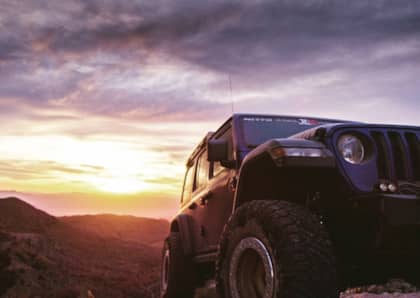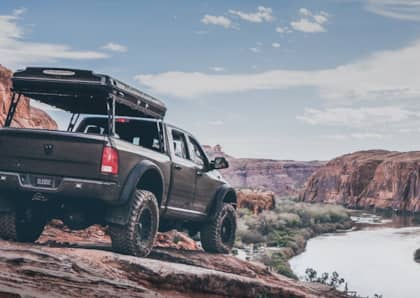BowTie Adventure: Giving a Chevy Tahoe Real Off-Road Chops
When it comes to off-road capable fullsize SUVs, the contenders are few and far between. While the long-removed Hummer H1 and H2 were serious trail machines, they lacked in practicality and affordability for the masses. Though the Toyota Land Cruiser is a great alternative for those looking for a fullsize SUV with real off-road chops, it comes with a hefty price tag. Today, most fullsize SUVs are not created with the off-road enthusiast in mind.
For this reason, we wanted to take dive into one of the most common SUVs still found on the road today- the Chevy Tahoe. While a new one will set you back tens of thousands of dollars, dig into the classifieds, and you will find that these once pricy SUV’s can often be had for less than 10k. While there are many generations of the Tahoe with varying ranges of aftermarket support, for this article, we are going to focus on a past project rig- a 2004 Chevy Tahoe 4x4.
Starting off with this generation Tahoe was done primarily because these are extremely common, very inexpensive, and have sizeable aftermarket support. In this article, we will take you through a series of upgrades that helped make this classic domestic platform a more dynamic backwoods exploration vehicle.

The Teardown Begins
Our 2004 was picked up with a little over 90,000 miles on the odometer, which is not much concern for the 4.8L V8 engine or 4L60e transmission. The SUV had been a pavement pounder for its entire life, so we got lucky that there was not much in the way of overly worn components out of the gate. If you are curious as to why we did not start with the more powerful 5.3L, it simply comes down to this Tahoe was a few grand less than others with the 5.3L. Both make good power and can easily be beefed up if you’re looking to pump up the power.

Tie Rods
One of the biggest known weak links for the ½-ton Chevy truck and SUV platforms are the tie rods. To make sure yours will not collapse, you have a few options. One being a basic sleeve that gets welded onto the existing steering link. The other is a full replacement link such as the one shown here from CST Suspension. The sleeves are much cheaper, but you’re getting a better overall product when you upgrade the entire steering link. Whatever your budget can stomach is what you should do. Stock just isn’t a safe bet off-road.

Skyjacking
There are a few companies that offer full suspension systems for the 2004 Tahoe. We opted for a six-inch lift from Skyjacker as it was cost effective and gave us more than enough room for our 35-inch tire goals. This generation Tahoe uses a torsion bar IFS setup with a multilink coil-sprung solid axle configuration out back. Admittedly, the torsion bar independent front suspension is probably one of our least favorite setups as it limits your travel and ride quality over a more modern coil-over-strut or coilover configuration. Skyjacker does a good job of optimizing what is there, but keep in mind that these styles of kits are not really designed for hardcore wheeling. If you want more off-road performance, expect to pay more for a custom long-travel setup.

Gearing
One area that you’ll want to invest to keep the performance where it needs to be is differential gearing. Adding on larger tires and extra gear is going to make a major impact. For ours, we moved up to a numerically higher 4.56 differential gearset. This put us closer to factory power with our 35-inch-tall tire.

Grappler Adventure
Speaking of 35s, that was the max tire we felt we really needed. This was never going to be a rockcrawler of any sort. So, going with anything larger would be a hit to our wallet and performance. Not to mention, the wheelwells of the Tahoe are not overly spacious. For the type of terrain this SUV would see in the Southeast, we opted for a 35x12.50 Nitto Trail Grappler. This is one of the most versatile mud-terrain radials we’ve tested. Given the type of knuckle-lift suspension we were using, we opted for an 18x9 AX186 wheel. This gave us the backspacing we needed and enough sidewall to drop the air pressure safely on the trail.

Air Flow
Normally, we are not big fans of cold-air intakes on our off-road rigs. Often times they are not as good as filtering out dust, dirt, and water as the stock air box. However, we were willing to try a few easy mods to try and increase the power of the 4.8L. We ended up installing an S&B Filter system, which proved to be a very easy-to-service and well working setup. Seat of the pants, it felt better, but we never placed it on a dyno.

Rumble Up
The one area our SUV had a bit of rust was on the exhaust. So, we used an Ultra Flow kit from DynoMax to replace the rotted original pieces. The single-in, single-out muffler gave a bit more rumble, but was not overly obnoxious. A great balance of value and performance for sure.

Programming
To calibrate the speedometer correctly for the new gears, we picked up a handheld programmer from Superchips. This unit also allowed us to correct for the new tire size. We didn’t utilize many of the performance (octane) functions of the programmer as we were satisfied with the power overall.

Dual Purpose
In stock form, the Tahoe is a great multipurpose rig. There is a ton of interior space, making it great for camping and everyday hauling. Adding the lift made for a nice visibility boost and gave way for a much better set of treads that what were on it. The 4.56 gears were really all it needed to keep overdrive active on the highway and make high-range useable in the sand and mud. We would classify it as only OK as a tow rig. So long as you have a good brake controller, towing is livable, but the coil sprung rear suspension could have benefited from a set of helper air bags.

Trail Thoughts
If you’re just doing light wheeling and backwoods exploring, these rigs work great. They have plenty of room for gear and enough power that being loaded down with your friends or family doesn’t impact performance. It’s no Jeep Wrangler and should not be used as an alternative for one. Dropping our Trail Grapplers to 15psi made the ride quality and traction work for our needs. The interior space is great, so we never ran out of room for gear storage. Overall, this was a vey cost-effective way to build light-duty wheeler with V8 power and excellent highway manners.

Looking for the ultimate bugout vehicle? Check out Alpha Van.











